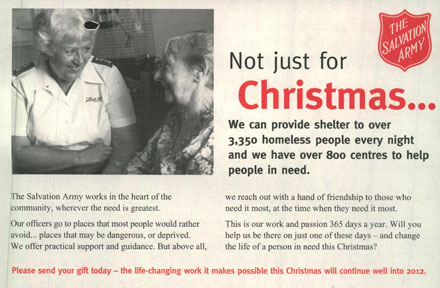Case study: Salvation Army
06 Aug 2012

Background
The Salvation Army is a worldwide Christian church and registered charity. Working in 124 countries, The Salvation Army demonstrates Christian principles through practical support; offering unconditional friendship and help to people of all ages, backgrounds and needs. Today The Salvation Army extends a helping hand to people who are homeless, friendless and in need.
Campaign objectives
In 2010 The Salvation Army planned to door drop their banker pack prior to Christmas as this is the most responsive time of year for people to give and to recruit new supporters. However, because of heavy snow during the delivery period, some of the packs were delivered later than planned (post Christmas).
The banker pack did not work as well as expected so The Salvation Army wanted to door drop the pack again in 2011 to ascertain whether the snow and late delivery had impacted the results. The Salvation Army believed they could also improve on the 2010 results through better targeting so they asked TNT Post to produce a door drop plan as part of their donor acquisition media mix to generate donations and raise awareness for their Christmas 2011 Appeal.
Solution
TNT Post used The Salvation Army's donor database to analyse the responder files from the previous year and look at historic performance, donations and potential. This information was then profiled and scored throughout the UK, to understand the best sectors to deliver to for the 2011 appeal, for the best return on investment.
TNT Post looked at specific Mosaic characteristics of a typical donor and fed them into the model for the door drop campaign but also to understand the impact of door drop media and its place within the media mix for acquisition appeals.
The door drop was part of a larger media campaign, including DRTV, radio, inserts, press and cold mail. The charity wanted to have as many touch points as possible to engage and recruit new supporters. Door drop was key to this marketing mix as traditionally the response was good.

Creative
The envelope had “Urgent Delivery” on the front of the pack to grab consumers’ attention. There were pictures and case studies of The Salvation Army’s work with homeless and older people and families living in poverty to engage consumers and ask them to donate a Christmas gift. The pack also contained a Christmas card and encouraged consumers to sign the card and send it back so The Salvation Army could give it to a homeless or lonely person to show them that someone cares.
Results
The number of donations increased from the previous year by 42%. The campaign generated a total ROI of £2.12; this was an improvement on the previous years ROI by an additional £0.58
Comment from The Salvation Army
“We were really pleased with the results from the 2011 Christmas door drop appeal and we hope to build on the success of the profiling model with a larger campaign in 2012.” Alex Kelly, The Salvation Army

1.png)


Please login to comment.
Comments